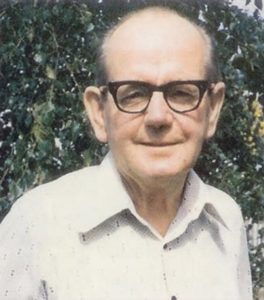
Australian Tom Bowen developed the healing technique named after him
I remember seeing a billboard on the side of the road once. It had a picture of this tremendous hunk of sizzling juicy steak topped with a little sprig of parsley. The caption read, “Australian for salad.”
The message is crystal clear. The “salad” is merely dressing for the real meal.
That makes me think of how most people look for pain relief. They don’t particularly care how it gets done, as long as it works and doesn’t leave them worse off than they started.
That’s why I thought of that billboard again when I sat down to write to you about this technique developed just a little over 50 years ago by Australian Thomas Bowen. It’s amazingly gentle, non-invasive, and instead of forcing the patient’s body to do something it simply induces the body to heal itself.
In other words, the technique doesn’t get in its own way when treating pain and other conditions. It lets you get right to the “main meal” of pain relief. But that’s not all.
There’s dessert, too.
Amazing Healing Power
Tom discovered and refined his technique while trying to help relieve his wife’s asthma. He didn’t have any formal training, but had observed that certain movements on the body had particular effects.
Profound effects.
Joint pain, sore muscles, and migraines… gone. Sciatica. Scoliosis. Fibromyalgia. Gone.
Even things that don’t seem related to the muscles, like asthma, infertility, and premenstrual syndrome. Bronchitis, constipation, and ear infections… Crohn’s disease, colic, and hemorrhoids. All better.
How about some scientific proof?
A recent study accepted and published by the First International Fascia Research Congress used the Bowen Technique on volunteers, then measured both their immediate and sustained increase in hamstring flexibility after a single session. All participants in the Bowen Technique had significant improvement while the control group did not.
But that’s not what makes this study so groundbreaking. The group of volunteers who received the single session of Bowen therapy maintained those flexibility increases a full week later. No other study has shown that kind of increase to hold more than 24 hours from other treatments like tissue heating, stretching, loading or exercise.
Of course, these results aren’t a surprise to Bowen therapy practitioners and their patients. That’s because most patients only need 1 to 3 treatments… and then they’re better.
The Bowen Technique, also referred to as Bowenwork, Bowen therapy, and Bowtech, is not chiropractic work, or manipulative massage. It’s not acupressure, Reiki, or quite like anything else you’ve heard of…
It works through the dynamic relationship between the autonomic nervous system (ANS) and the muscular system by using a series of gentle massage motions called “moves.” These moves help the body recognize that it is out of balance and self-correct through the body’s own healing processes. A series of moves make up a procedure. And a series of procedures make up one session of Bowen Therapy.
What to Expect During a Bowen Therapy Session
What to wear?
Bowenwork can be performed through light clothing. Anything less is at your discretion and comfort. Sheets and blankets are always provided to keep you comfortable and maintain your privacy.
Pre-session
Your practitioner will discuss your pain and health background with you before the session, and explain what is going to happen.
The Session
There are different types of moves that open up or stimulate different parts of the body’s healing processes. A gentle, rolling motion is used for all the moves, but the target often varies between these:
- Stretch Reflexes: These motions affect the muscle and tendon tissue, telling the ANS how stretched or tensed an area is, and how to relax it.
- Joint Proprioceptors: Moves that are performed around a joint, such as a knee or elbow, help the joint to return to a normal state. This will help areas of limited mobility such as “frozen shoulder.”
- Fascia: These long sheets of connective tissue play a major part in how the nerves and muscles interact. Moves are all performed by gently working in the superficial fascia.
- Spinal Reflexes: These moves stimulate reactions to the internal organs through viscerosomatic spinal reflexes.
- Harmonic Vibrations: The body has its own natural pattern of vibration. Bowtech moves help bring those vibrations back into balance for overall wellness and peace.
- Lymphatics: The immune system is stimulated by some Bowtech procedures that initiate lymphatic draining.
Detoxification
A two to five minute pause is taken between moves. These all-important pauses allow the body to accept the work being done and adjust to the new position of relaxation.
Bowen therapy sessions generally last from 30 to 45 minutes and are typically spaced a week apart. It is recommended that you have no bodywork done between sessions or immediately before a session.
Three sessions are usually scheduled with new patients but its fairly common to experience pain relief after the first session.
How Does Bowen Therapy Work?
As Bowenwork practitioner Dr. Heidi Rootes of the Vancouver Vitality Clinic explains, the Bowen technique works by “challenging” the muscles. The moves stretch or contract the muscle by gently pressing in to the superficial fascia.
However, because the brain didn’t send a signal for the muscle to move, and the muscle is sending a signal that it has moved, the brain corrects the imbalance by signaling the muscle to return to its default relax position.
To summarize:
1. The practitioner “challenges” the muscle with a move.
2. The muscle says, “Oi! I moved!”
3. The brain says, “I didn’t tell you to move, goofball. Go to default mode and relax.”
4. The muscle listens to the brain and completely relaxes.
Remember, your muscles and nervous system are close pals. When a muscle releases its tension, nerves are often released along with it, relieving pain. Limited mobility and tension in the area are both improved.
Even Bowenwork practitioners don’t have a complete understanding of exactly why it works. It seems simple enough, yet scientists can’t verify exactly why Bowen patients see and feel the amazing results that they do. It seems that sometimes the brain simply has to be told when the body is out of balance so it can go to work sending the right signals to fix the problem.
Who Can Have Bowenwork Done?
In short, anyone. Bowtech is so gentle that even infants suffering from colic or birth trauma can be treated. Some patients find it so relaxing they actually fall asleep during the session.
There are no contraindications for Bowen therapy, so while something like a slipped disc might be keeping you from other bodywork, Bowenwork can be done on anyone with pain, no matter what kind of pain it is.
I should caution that the Bowen technique is not a miracle method or a cure-all, end-all technique. It’s not even considered an alternative medicine by most experts, but rather a complement to simultaneous (non-bodywork) treatments. It just happens that so many people are finding relief after one or two therapy sessions that people are ditching their doctors and heading straight to their nearest Bowtech practitioner.
What to Look for in a Bowtech Practitioner and
Where to Find One
The easiest way to find a local accredited practitioner is through the Bowen Therapy Academy of Australia, run by Elaine & Oswald Rentsch who learned directly from Tom Bowen.
Their Practitioner Search page helps you find accredited Bowtech practitioners worldwide. They also offer a helpful What to Look For page so you know you’ve found a good practitioner.
Here are a few more tips to make sure you’re getting the best possible treatment starting from your very first session:
A proper Bowen Therapist should always…
- stop moves every two to five minutes so your body can adjust to the procedures and begin its healing process.
- tell you what to do between sessions, as well as teach you the exercises so you can perform them on your own.
A proper Bowen Therapist should never…
- use too many procedures in one session, as it will overload your body into working against itself.
- use an uncomfortable pressure during movements.
Interested in learning more about Bowen therapy? Visit www.bowenwork.com or watch the short introductory video below…
References
Marr M, Lambon N, Baker J. Effects of The Bowen Technique on Flexibility Levels: Implications for Fascial Plasticity. Accepted abstract at the First International Fascia Research Congress. 2007.


